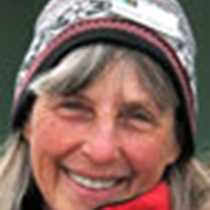Kelp Bay
One of the best ways to wake up in Southeast Alaska or for that matter, any place in the world, is to hear that a humpback whale is in sight. Just ahead of the ship a single animal repeatedly lunged up and out of the water to engulf its prey. It surfaced several times following each gulp then lifted its flukes for a steeper descent. Breakfast was delayed to allow a bit more observation time, then we too descended to forage.
Our spirits were not dampened by the shades of gray at the entrance to Kelp Bay. An eager group climbed into kayaks for an energetic one-way trip to the end of the inlet. The Sea Bird motored off, leaving the paddlers in the peaceful quiet surrounded by steep walls blanketed with dense forest, broken only occasionally by a wispy waterfall tumbling from the heights.
The ka-chunk, ka-chunk, ka-chunk of the anchor chain announced the ship’s arrival at the head of the bay where hikers and shorter-duration kayakers planned to spend the rest of the morning. From a distance the shoreline appeared lush and green but unremarkable. Once ashore, we realized that the sedges and grasses shown in the photo were bordered farther inland by a luxuriant wildflower meadow. Our rubber boots squished past pale blue geraniums, purple irises, red-orange paintbrushes, and magenta shooting stars. Giant cow parsnips towered over stalks of miniature orchids and scattered buttercups. Some of the hikers entered the forest and found recent tracks on a regularly used bear trail. Kayakers explored the bay, and by lunch all were warm and dry back aboard the Sea Bird.
Two representatives from the Alaska Whale Foundation joined us for lunch and later presented slides to explain their research on humpback whales. It was an excellent orientation to the complex feeding behavior and general natural history of these magnificent creatures.
During the remainder of the afternoon and well into the night we traveled north. Our route led us through Chatham and Icy Straits to allow an early morning approach into Glacier Bay, the focus of tomorrow’s adventures.
One of the best ways to wake up in Southeast Alaska or for that matter, any place in the world, is to hear that a humpback whale is in sight. Just ahead of the ship a single animal repeatedly lunged up and out of the water to engulf its prey. It surfaced several times following each gulp then lifted its flukes for a steeper descent. Breakfast was delayed to allow a bit more observation time, then we too descended to forage.
Our spirits were not dampened by the shades of gray at the entrance to Kelp Bay. An eager group climbed into kayaks for an energetic one-way trip to the end of the inlet. The Sea Bird motored off, leaving the paddlers in the peaceful quiet surrounded by steep walls blanketed with dense forest, broken only occasionally by a wispy waterfall tumbling from the heights.
The ka-chunk, ka-chunk, ka-chunk of the anchor chain announced the ship’s arrival at the head of the bay where hikers and shorter-duration kayakers planned to spend the rest of the morning. From a distance the shoreline appeared lush and green but unremarkable. Once ashore, we realized that the sedges and grasses shown in the photo were bordered farther inland by a luxuriant wildflower meadow. Our rubber boots squished past pale blue geraniums, purple irises, red-orange paintbrushes, and magenta shooting stars. Giant cow parsnips towered over stalks of miniature orchids and scattered buttercups. Some of the hikers entered the forest and found recent tracks on a regularly used bear trail. Kayakers explored the bay, and by lunch all were warm and dry back aboard the Sea Bird.
Two representatives from the Alaska Whale Foundation joined us for lunch and later presented slides to explain their research on humpback whales. It was an excellent orientation to the complex feeding behavior and general natural history of these magnificent creatures.
During the remainder of the afternoon and well into the night we traveled north. Our route led us through Chatham and Icy Straits to allow an early morning approach into Glacier Bay, the focus of tomorrow’s adventures.




